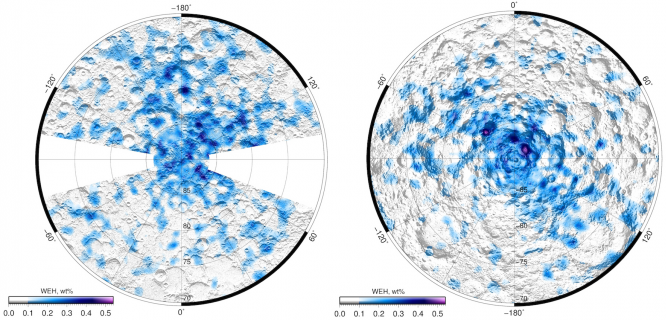
LEND (Lunar Exploration Neutron Detector) is a Russian experiment onboard NASA Lunar Reconnaissance Orbiter (LRO) mission.
Russian participation in the Lunar Reconnaissance Orbiter 2009 project is defined by the Executive Agreement between NASA and the Federal Space Agency of Russian (now State Space Corporation ROSCOSMOS) that was the customer of the LEND instrument developed and manufactured at Space Research Institute of the Russian Academy of Sciences.
Scientific Goals
- to search for hydrogen-bearing compounds, including water ice, in the lunar upper subsurface with neutron sounding.
Mission Overview
LEND is a Russian collimated neutron detector, a part of the scientific payload of Lunar Reconnaissance Orbiter (LRO, NASA), which explores Moon from its orbit.
The LEND neutron detector records the flux of secondary neutrons escaping from the lunar surface — so-called neutron albedo. These neutrons are born in the upper subsurface layer 1–2 meters thick, in the interactions with cosmic rays and during the decay of natural radioactive elements. On their way to the surface, they are slowed down and absorbed by the nuclei of the main rock-forming elements. Thus, the neutron flux coming out of ground depends on the substance composition and first of all on the presence of hydrogen or hydrogen-bearing compounds. Knowing hydrogen distribution in the ground, one may judge about the presence of water ice or bound water in minerals there.
First maps showing the distribution of water in the lunar regolith at south and north poles were made, using the data of neutron radiation measurements from the polar regions of the Moon. The Moon turned out to be quite a "wet" place: in some regions hydrogen-enhanced content can reach up to 5 % by mass, which is more than in Sahara desert on the Earth.
Just two months of orbiting the Moon were sufficient to get fundamentally important data and, subsequently, to draw maps of water distribution in the lunar circumpolar regions. They showed that regions with enhanced hydrogen content in the regolith do not match the previously known permanently shadowed regions in the bottom of lunar polar craters. This was an unexpected result, since it had long been assumed that probable local regions with high hydrogen content should coincide with the permanently shadowed regions (PSRs) in the vicinity of the Moon poles. Thus, LEND data forced a new look at the "water cycle" on the Moon.
Moreover, LEND provided basic data, which (in combination with other instruments' output) were used by NASA when choosing a region for lunar surface guided bombardment in the following LCROSS experiment (short for Lunar CRater Observation and Sensing Satellite). LCROSS, a spacecraft, which had been launched into space together with LRO, followed Centaur upper stage of the launcher. This pair was directed to the lunar surface, and namely to the Cabeus crater near the pole. After Centaur had hit the surface, a cloud of debris was released and studied directly by instruments onboard Shepherding Spacecraft, which followed Centaur and, later, by LRO instruments.
The results of the LEND experiment are used for planning future scientific and exploration missions to the lunar poles: Luna-25, Luna-27, and following.
The predecessor of LEND was the HEND instrument, also made at the Space Gamma-Spectroscopy Laboratory of IKI (now the Nuclear Planetology Department) for the 2001 Mars Odyssey orbiter (NASA, launched in 2001). But lunar instrument required very high spatial resolution. To achieve it, a conceptually new device — a collimator made of boron and polyethylene — was developed. In fact, it is a very thick shell, installed in such a way that it absorbs epithermal neutrons coming from outside the instrument's field of view. Collimation technique makes it possible to map the flux of epithermal neutrons coming from the lunar surface with a resolution of 10 km from 50-km-high orbit.
Main parameters
- Detected neutrons energies: from thermal to 15 MeV
- Temporal resolution: variable, >1 s
- Spatial resolution on the surface: ~10 km from the 50 km orbit
- Vertical resolution in the subsurface: ~1–2 m
Leading Organizations and Principal Investigators
- State Space Corporation ROSCOSMOS
- Space Research Institute of the Russian Academy of Sciences (IKI)
- Principal Investigator of the experiment: Dr. Igor G. Mitrofanov (IKI)
In Collaboration With
- Research Institute of Atomic Reactors (NIIAR, Dimitrovgrad-10)
- Mechanical Engineering Research Institute of the Russian Academy of Sciences (IMASH)
- Joint Institute for Nuclear Research (JINR, Dubna)
- Sternberg Astronomical Institute Moscow State University (GAISH)
- Ioffe Physical-Technical Institute (St. Petersburg)
- Specialized Scientic Research Institute of Instrument Engineering (SNIIP)
- NASA Goddard Space Flight Center (GSFC, USA)
- University of Arizona (UofA, USA)
- University of Maryland (UMD, USA)
- Catholic University (USA)
Main Mission Publications
- A.B. Sanin, I.G. Mitrofanov, M.L. Litvak, B.N. Bakhtin, J.G. Bodnarik, W.V. Boynton, G. Chin, L.G. Evans, K. Harshman, F. Fedosov, D.V. Golovin, A.S. Kozyrev, T.A. Livengood, A.V. Malakhov, T.P. McClanahan, M.I. Mokrousov, R.D. Starr, R.Z. Sagdeev, V.I. Tret'yakov, A.A. Vostrukhin, Hydrogen distribution in the lunar polar regions, Icarus, Volume 283, 2017, Pages 20-30, ISSN 0019-1035, https://doi.org/10.1016/j.icarus.2016.06.002
- Litvak, M.L., et al., Global maps of lunar neutron fluxes from the LEND instrument. J. Geophys. Res. 2012, 117 E12, https://doi.org/10.1029/2011JE003949
- Mitrofanov, I. G. et al., Hydrogen Mapping of the Lunar South Pole Using the LRO Neutron Detector Experiment LEND, Science, 2010, Vol. 330, no. 6003, https://doi.org/10.1126/science.1185696
- Mitrofanov, I. G. et al., Experiment LEND of the NASA Lunar Reconnaissance Orbiter for High-Resolution Mapping of Neutron Emission of the Moon, Astrobiology, 2008, Vol. 8, no. 4, pp. 793-804, https://doi.org/10.1089/ast.2007.0158
Websites
- The LEND experiment on the website of the IKI Nuclear Planetology Department
- The Lunar Reconnaissance Orbiter project on the NASA portal
- Lunar Reconnaissance Orbiter website on the NASA Goddard Space Flight Center portal
Gallery
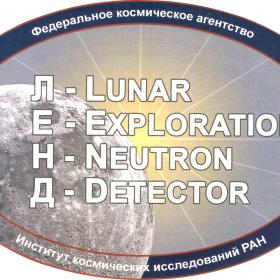
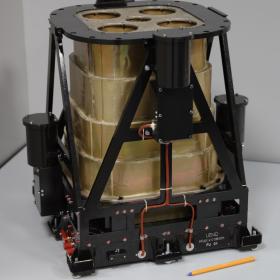
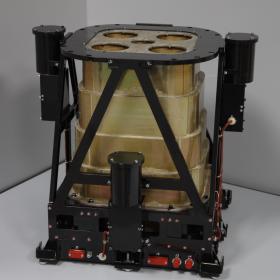

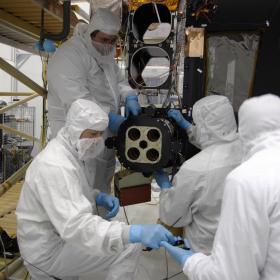
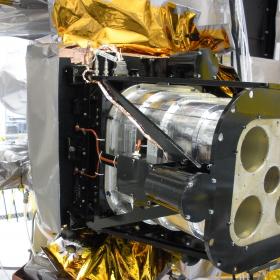
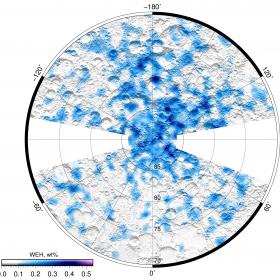

Lunar Reconnaissance Orbiter / LRO
Status: in operation
Launch: 18.06.2009, 21:32:00 UTC (19.06.2009, 01:32 Moscow time), Cape Canaveral Spaceport, Atlas V / Centaur
Leading space agency: NASA
SCN: 35315
NSSDC ID: 2009-031A
Main website: Lunar Reconnaissance Orbiter
LEND / ЛЕНД
Status: in operation
Leading space agency: ROSCOSMOS
Main website: Russian neutron detector LEND for NASA Lunar Reconnaissance Orbiter space mission
